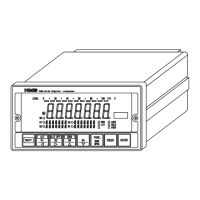29
5−3−1.
To make calibration on the instrument.
When the new instrument is purchased, or re−use is required with the new specific conditions,
execute the calibration with whichever method as follows:
(1)
When loading condition and output condition for load cell are clear.
(In case of desired accuracy is less than 1/1 000 or so.)
Warning ● The calibration accuracy by the procedure is less than 1/1 000 or so.
When more precise accuracy is required, make calibration with actual
load according to the paragraph 5−3−1. (2). The accuracy described
here is combined accuracy with the instrument and the sensor to be
connected with. If there may be another error factors such as
mechanical elements and so on, it will become out of warranty, so care
should be taken fully.
● Rated output value for load cell used in calculation should be the
same value written in “Inspection data”.
For example, we’ll show the calibration procedures in the following condition, that is, 3 points
of load cells with 3 mV/V of rated output and 5 t of rated capacity.
Tare weight : 1.5 t
Weighing capacity : 5 t
Maximum display value : 5 000
1
Calculate the output of load cell at the maximum display from the above conditions.
(Output of load cell
at maximum display.
(Rated output)+(Rated output)+(Rated output)
Numbers of load cell
×
××
×
3 points ×
××
× 5 t
=
==
=
(Numbers of load cell)×
××
×(Rated capacity)
(Weighing capacity)
=
==
=
3 points
3 mV/V + 3 mV/V + 3mV/V
×
××
×
5 t
=
==
=
1 mV/V
2
Execute the calibration with load cell section applied initial load(tare weight), according to the
paragraph 5−2−1. In this case, make input to “5 000” in step 5, and “1.000 00” in step 7 each.

